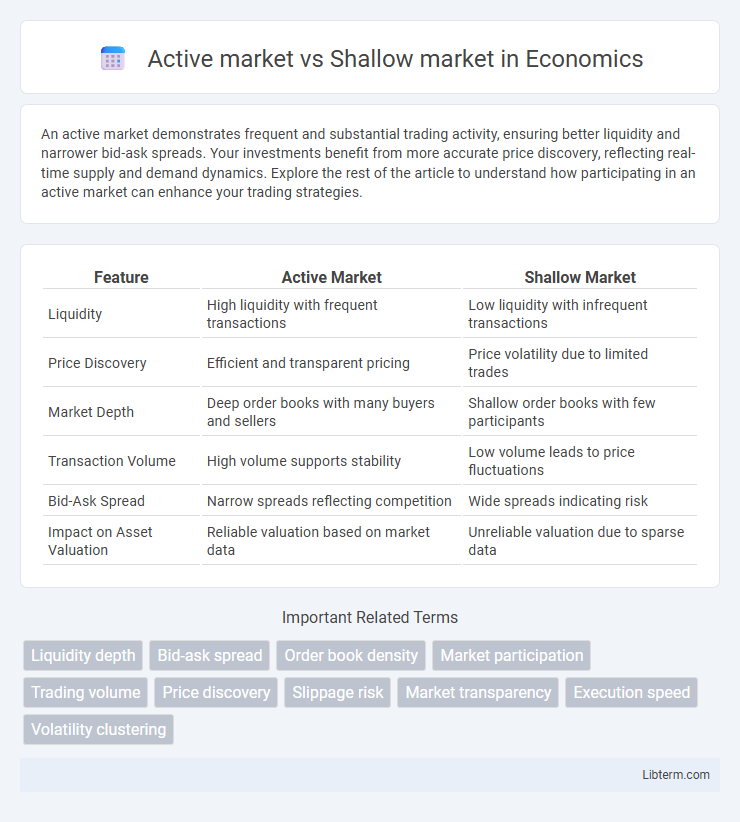An active market demonstrates frequent and substantial trading activity, ensuring better liquidity and narrower bid-ask spreads. Your investments benefit from more accurate price discovery, reflecting real-time supply and demand dynamics. Explore the rest of the article to understand how participating in an active market can enhance your trading strategies.
Table of Comparison
| Feature | Active Market | Shallow Market |
|---|---|---|
| Liquidity | High liquidity with frequent transactions | Low liquidity with infrequent transactions |
| Price Discovery | Efficient and transparent pricing | Price volatility due to limited trades |
| Market Depth | Deep order books with many buyers and sellers | Shallow order books with few participants |
| Transaction Volume | High volume supports stability | Low volume leads to price fluctuations |
| Bid-Ask Spread | Narrow spreads reflecting competition | Wide spreads indicating risk |
| Impact on Asset Valuation | Reliable valuation based on market data | Unreliable valuation due to sparse data |
Understanding Active Markets
Active markets feature frequent transactions and high liquidity, enabling accurate and timely price discovery for assets. These markets reflect current supply and demand dynamics through consistent trading volumes and transparent pricing information. Traders and investors rely on active markets for reliable valuation benchmarks and efficient entry or exit opportunities.
Defining Shallow Markets
Shallow markets are characterized by low trading volumes and limited liquidity, causing significant price volatility when individual trades occur. Unlike active markets, where numerous buyers and sellers provide stable pricing and tight spreads, shallow markets often experience wide bid-ask spreads and inefficient price discovery. These conditions increase the risk for investors and traders due to the potential for sudden price swings and difficulty entering or exiting positions.
Key Differences Between Active and Shallow Markets
Active markets exhibit high trading volumes, tight bid-ask spreads, and robust liquidity, enabling efficient price discovery and minimal transaction costs. In contrast, shallow markets suffer from low trading activity, wide spreads, and limited liquidity, resulting in price volatility and increased risk for traders. These key differences impact market stability, execution speed, and investor confidence significantly.
Liquidity: The Lifeblood of Market Activity
Liquidity stands as the lifeblood of market activity, with active markets exhibiting high transaction volumes and tight bid-ask spreads that enable swift asset conversion without significant price impact. In contrast, shallow markets suffer from low liquidity, characterized by sparse trading activity and wider spreads, leading to greater price volatility and difficulties in executing large trades promptly. The liquidity disparity between active and shallow markets directly influences market efficiency, price discovery, and investor confidence.
Price Discovery in Active vs Shallow Markets
Active markets facilitate efficient price discovery through high trading volumes and liquidity, enabling asset prices to reflect available information rapidly. In contrast, shallow markets suffer from low liquidity and sparse transactions, causing price discovery to be slow and often distorted by large trades or informational asymmetries. The depth of an active market mitigates volatility and enhances transparency, while shallow markets face higher bid-ask spreads and increased price manipulation risks.
Impact on Investor Strategies
Active markets, characterized by high trading volumes and liquidity, enable investors to execute large orders with minimal price disruption, facilitating strategic portfolio adjustments and risk management. In contrast, shallow markets exhibit low liquidity and wider bid-ask spreads, increasing transaction costs and the likelihood of price volatility, which compels investors to adopt cautious, long-term strategies or reduced trading frequency. Understanding these market conditions is essential for optimizing entry and exit points, minimizing slippage, and aligning investment horizons with market depth.
Volatility and Risk Factors
Active markets exhibit high liquidity with frequent transactions, resulting in lower volatility and reduced risk due to efficient price discovery. Shallow markets suffer from low liquidity, causing larger price fluctuations and increased volatility, which heightens risk for traders and investors. The limited number of participants in shallow markets amplifies price impact and market manipulation potential, further exacerbating financial risk.
Market Participation and Order Flow
Active markets exhibit high market participation characterized by numerous buyers and sellers engaging continuously, resulting in substantial order flow and tight bid-ask spreads. Shallow markets face limited participation with fewer participants submitting orders, leading to reduced order flow, wider spreads, and increased price volatility. Market depth in active markets supports efficient price discovery, whereas shallow markets often experience liquidity gaps and sporadic price movements.
Regulatory Considerations
Regulatory considerations in active markets emphasize transparency, liquidity, and frequent price discovery to ensure fair pricing and risk assessment under standards like IFRS 13. In contrast, shallow markets face increased scrutiny due to limited transaction volume and price variability, necessitating additional disclosures or valuation adjustments to address potential measurement uncertainties. Regulators demand rigorous documentation and justification for valuation techniques when observable inputs are insufficient, enhancing investor protection and market integrity.
Choosing the Right Market for Your Investments
Selecting the right market for your investments depends on liquidity and price stability; active markets feature high trading volumes and narrow bid-ask spreads, offering ease of entry and exit. Shallow markets, characterized by low liquidity and wider spreads, can result in higher volatility and execution risks, potentially impacting investment returns. Understanding market depth and participant activity helps investors align their strategies with risk tolerance and investment goals.
Active market Infographic

 libterm.com
libterm.com